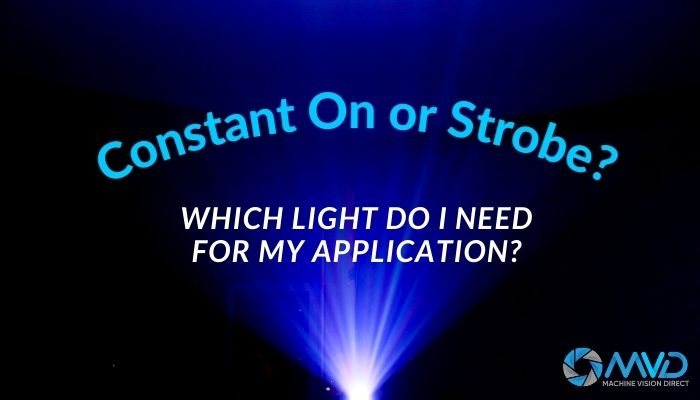When it comes to machine vision lighting, there are many technicalities as to how to properly light any given application. Many customers look for a "one size fits all" solution but unfortunately that just is not possible, hence why there are so many different types of machine vision lights available. Beyond the mechanical fit, form factor and Illumination method of a light, there is an additional choice that needs to be made when selecting a light. Do you need to strobe or can you use a constant on light?
Thankfully, the answer to this is usually (but not always) a pretty simple choice!
Before we go any further, lets define some terms:
Constant On Operation - When a light is turned on and remains on throughout the entire operation, regardless of whether the camera is imaging or not
Strobe Operation - When a light is turned on momentarily while an image is being captured (strobing is also often referred to as pulsing)
OverDrive Operation - When a light is strobed with a higher current in order to maximize brightness. A light in OverDrive Operation will be strobing. Note that all Smart Vision Lights OverDrive Lights include SafeStrobe Technology which prevents premature LED failure due to over-current situations
As a general rule of thumb, if an object is sitting still, you can use a constant on light. If an object is in motion, then we will want to look into strobing, however this isn't the full story!
The reason a target in motion requires a strobe light is generally to prevent motion blur. When a camera images and the image being recorded changes during the recording of a single exposure, the image can be subject to a streak affect. This is generally caused by one of two things:
- Elongated Exposure Times
- Rapid Motion of Objects in Frame

The existence of motion blur can make it incredibly difficult to do any inspection or analysis on an image, which can result in false failures of good products. In order to mitigate motion blur we can shorten the exposure time of the camera. When the exposure time is shortened the image object will have not moved as far while the image is being captured, and therefore there will be reduced blur. The downside of this is that the image will appear darker due to the lower exposure time. To get the image brighter we will need more light. There is two ways to achieve this: Option 1 is to add more physical lights, option 2 is to get more light output from our existing lights, this is where OverDriving comes into play! OverDriving LED's can often result in up to 10x the light output of the same LED in constant on operation!
Now what about stationary objects?
Stationary objects can also benefit from a strobing/overdriven light. Oftentimes a single constant on light may not have enough output in order to properly image a stationary object which will result in a dark image. In order to brighten our image without excessively increasing exposure time, we can add more light. As we learned earlier, the easiest way to get additional light output is to overdrive a light!
The Pros of Strobing Lights:
- Reduced Motion Blur
- Reduced Exposure Times when Overdriving
- Less Physical Lights Required
- Bonus! Extended LED Life
But what about Cons?
- More Complex Wiring Required
- Strobing can be bothersome to equipment operators when not properly shielded.
- Limited Duty Cycle - OverDriven Lights generally have a 10% Duty Cycle (Non overdriven Lights do not have this limitation when strobed)
Which Lights can be overdriven? When it comes to Smart Vision Lights, any light with the prefix "OD" can be overdriven. Lights with Multi-Drive can also be Overdriven. Examples of OD lights are the ODR80, ODR130, ODL300, ODLX150, ODLX300 and more.
Examples of Multi-Drive Lights are the LM45, LM75, LM150, LX300, RM75, RM140 and more
Standard Lights such as the R80, R130, L300, LX150, LX300, and more can be strobed but cannot be overdriven.
If you ever need help selecting a light, please do not hesitate to contact the Machine Vision Direct Applications Team at Support@MachineVisionDirect.com or (331) 684-7466

